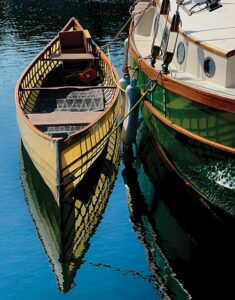- Home
- Boat Building
- Restoration
- Paint
- Bottom Paint
Bottom Paint, Antifouling for Wooden Boats.
Choosing a bottom paint for your boat used to be simple, the more toxic the better.
Fortunately
there is now a
greater awareness of the
impact on the environment that man made pollutants are having.
And while the effect that the paint on your small boat may have might seem insignificant, add it to the accumulated effect of all the paint from the other small boats and it becomes quite a problem.
The trouble is that while the biocides
in the bottom paint deter the organism which foul the boat they also
have a detrimental effect other marine life and the very waters which
we use our boats to enjoy.
Before buying an antifouling paint do check the latest regulations for your sailing area.
Copper is being banned by many port authorities and even scrubbing off is being legislated against in some areas.
To antifoul or not?
A wooden boat that remains in the water all
year is going to need
antifoul bottom paint.
However, one which is regularly kept ashore won't need the same kind
of
protection.
Most
fouling organisms survive in specific environments, salt water
organisms will die off in fresh water or in the air, so a boat which
regularly moves from one to the other may not need much if anything in
the way of protection.
And if you do antifoul, the choice of paint will also be influenced by
how and where you keep and use your boat.
The
amount of fouling can vary depending on temperature, salinity, water
quality and temperature as well as the amount of sunlight, the
and flow of the water and other pollution levels.
Because
most fouling occurs along the waterline where it is encouraged by
sunlight it is regarded as good practice to apply an extra coat or two
here and on the rudder, however these are areas which are easy to scrub
clean with out the need to haul out.
And any water pollution on the surface can affect the efficiency of the
antifoul.
So,
if you keep your boat in the water, check with your neighbours, the
marina and other boat users in your area to get an idea of the local
problems, and try to find the most effective but least toxic solution.
Types of Bottom Paint
The wide range of available antifouling paints
can be confusing.
Basically there are three main types;
- Erodible or self polishing
- Soft, traditional
- And hard or Ablative.
While the active ingredients in all three
tend to be similar it is the
how they are put together that determines the type.
Erodible
or self polishing;
In this type the active ingredients are suspended in a resin which will
once in the water begin to dissolve in a controlled way.
This allows fresh layers of the active biocides to be exposed on the
surface.
Traditional or Soft
These tend to be cheaper than the more modern self polishing.
They
use a much more simple resin binder to hold the biocides, so while they
offer good cheap protection, they are not as efficient over the season.
The soft type need to be applied shortly before launching, so check the
instructions on the tin.
One disadvantage of the softer bottom paints is that they have to be
removed every so often due to build up.
Hard or ablative
As
the name suggests these bottom paints are more resistant to abrasion.
As with the others the active ingredients are held within a resin,
however this is less soluble.
Ablatives use what is known as contact leaching which needs regular
movement through the water to be effective.
These paints are designed for high speed power boats, boats kept on a
mud berth and racing yachts.
Some other types;
Teflon
based bottom paint is also available, has been developed for racing
yachts, however it is not particularly effective as an antifouling if
used without a biocide.
One part modified
epoxy paints tend to contain the highest biocide levels of
any antifouling paint.
They
are durable, abrasion resistant, however they are difficult to remove
and do gradually lose their effectiveness when out of water.
Water-based antifoulings encapsulate the biocides in a
water-soluble polymer resin.
They don't lose their effectiveness when the boat is hauled and
re-launched, and are reasonably easy to recoat.
While they use very little or no solvent and thus contain very few
volatile organic compounds, they do still contain toxins.
Safety
The active ingredient in most bottom paints is methylene chloride, which is a carcinogen.
Read and obey the safety instructions on the tin for your own sake as
well as that of the environment.
If you are not sure whether you need to wear safety gear, wear it.
When
stripping off old bottom paint place a heavy duty tarp or cloth below
the hull before starting, and wear protective clothing and use a vacuum
system with any sander, vacuum up debris when done.
Previous posts
See What Others Have Posted
Bottom paint
I am maintaining Pete Culler "good Little Skiff" built in 2005 and have a question regarding bottom paint.
For years I was under the impression that …
Toreto worms, salt water and a lap strake hull
How long can I leave my 59 cc Seaskiff in the water in a canal in St James City FL before I need to worry about an infestation of toredo worms?
The …
Copper bottom paint
Hi how do you thin copper bottom paint that has dried up partially?












